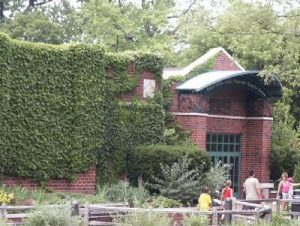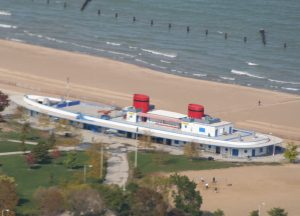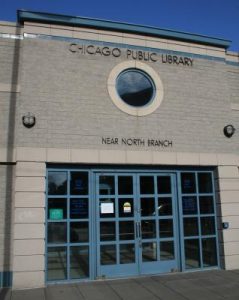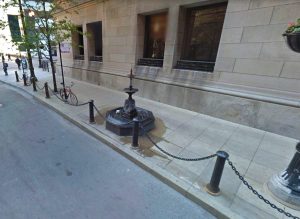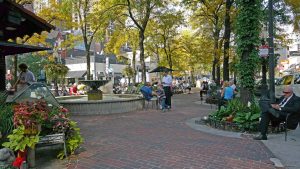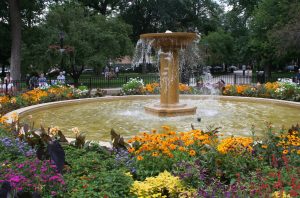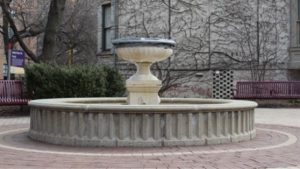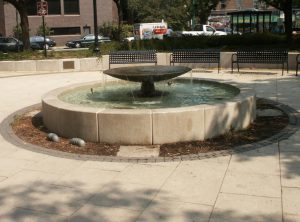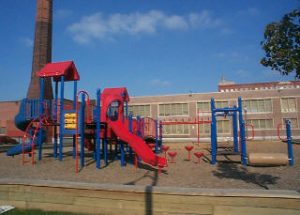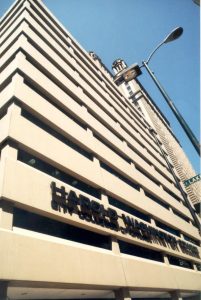4/23/2011
Mayor Richard M. Daley joined Chicago Public Schools officials and Near North Side community members for a visit to the site of the new Ogden International School of Chicago, one of the 19 schools constructed and renovated under the “Modern Schools Across Chicago” program.
“No other city in the nation has taken such a major step to assure that our children learn in modern, up-to-date environments,” Daley said at another stop on the “Neighborhood Appreciation Tour” he is making before he leaves office in May. “Opening a new school gives students and staff a fresh start, greater hope and an improved learning environment.”
The Modern Schools Across Chicago program is funded with City redevelopment funds from Tax Increment Financing districts — no state or federal funds are received. Since Mayor Daley assumed responsibility for CPS in 1995, CPS has opened 47 new schools.
“In the competition for the jobs of the tomorrow, which are the key to Chicago’s future, nothing is more important than continuing to improve our schools,” Daley said. “We must pay special attention to improving our neighborhood elementary and high schools, as we are here with this new facility.”
The new $58 million Ogden International School, at 42 W. Walton St., will open in the fall of 2011. The 110,000-square-foot school will include 24 academic classrooms, six kindergarten classrooms, gymnasium, library and student dining facility.
During the visit to Ogden, Mayor Daley highlighted some of the major accomplishments that the City and the residents of the 42nd and 43rd Wards, the heart of downtown, Lincoln Park and the Near North Side, have accomplished together:
-
In 2004, Mayor Daley opened Millennium Park to world-wide acclaim. Featuring the work of world renowned architects, planners, artists and designers, the 25- acre Millennium Park is the second most popular tourist attraction in Chicago.
-
The beautiful park, built through a public-private partnership, offers free art, music, culture, recreation and landscape design every day of the year. To date, more than 25 million people have visited Millennium Park since it opened.
-
The renaissance of the State Street retail district started in the early 1990s with the opening of the Harold Washington Central Library, followed by the street’s reopening to car traffic in 1996. Thanks to the many investments the City has made over the years, largely through TIF, State Street is once again a strong, vibrant retail, office and education corridor in the heart of the Loop.
-
To help hold Chicago’s position as the economic center of the Midwest, the City has invested more than $450 million in TIF-funded public-private redevelopment agreements in the Central Business District, including:
-
The relocation of corporate headquarters of major employers like: ArcelorMittal USA, the world’s largest steel manufacturer; NAVTEQ, a global provider of digital mapping services; United Airlines, the world’s largest airline; and Boeing Corp., which relocated its world headquarters from Seattle to Chicago in 2001.
-
The expansion of long-time area manufacturers like Blommer Chocolate.
-
The construction of retail facilities like the Bloomingdale’s Home Store inthe former Medinah Temple Building, and the Metra Market.
-
-
The revitalization of live theater in the Loop was made possible through four key
TIF allocations starting in the late 1990s.
-
Oriental Theater, 24 W. Randolph. Built a movie house, the longshuttered, 2,180-seat house theater underwent a $32 million renovation and reopened in 1998.
-
Palace Theater, 151 W. Randolph. Built as a vaudeville house and later used as a banquet facility, the 2,300-seat theater underwent a $32 million, TIF-assisted renovation. It reopened 1999.
-
Goodman Theater, Randolph & Dearborn. Adapted from two small movie houses, Goodman is a live-theater and commercial complex featuring an 800-seat main stage. The $44 million TIF-assisted complex opened in 2000.
-
The Majestic Building, State and Monroe, was reborn as a hotel and theater complex through a TIF-assisted redevelopment project in 2003.
-
-
Under Mayor Daley’s leadership, the City has invested more than $350 million in TIF-generated public infrastructure and facility improvements, including: Loop lighting and streetscape improvements; renovations to the Chicago Cultural Center and the Grant Park garages; public transit improvements; street reconstruction and sidewalk upgrades.
-
The Chicago Department of Transportation led the reconstruction of Wacker Drive from Randolph to Michigan. This project involved the reconstruction of the obsolete 1920’s roadway and improving Lower Wacker with new lighting and architectural enhancements. Today, the second reconstruction phase of Wacker is under construction, which will complete the entire project started in 2000.
-
Twenty years ago, After School Matters began as Gallery 37 under the leadership of First Lady Maggie Daley on the vacant site of Block 37 at State and Randolph. Today, After School Matters is the largest out-of-school program for teens in the nation, offering 20,000 opportunities for young Chicagoans to learn and grow this year.
-
The $29.5 million renovation of Harold Washington College, located at 30 E. Lake Street, completed in 2004 made the campus a better learning environment for students and more accessible to all Chicagoans.
-
As the transportation center of the city, the CTA has a large presence downtown on the Near North Side. Over the years, there has been a tremendous amount of investment in improving the rail and bus systems that service the wards.
-
The CTA opened the new Orange Line in 1993 and the completely renovated Green Line in 1996 and launched the Pink Line in 2004, all of which bring riders downtown.
-
System-wide modernization improvements to the Brown and Blue Lines have allowed for longer trains and increased service speeds.
-
The CTA built new stations at the Washington/Wells in 1995 and Harold Washington Library Center in 1997.
-
The agency completely renovated five stations in the area, including: Clinton/Lake in 1996; Chicago/State in 2001; Jackson/State in 2006; Jackson/Dearborn in 2007; and North/Clybourn in 2009.
-
There are a total of 53 bus routes that run through downtown in the 42
nd Ward and 23 serving the residents of the 43rd Ward.
-
-
There are a total of 53 bus routes that run through downtown in the 42
nd Ward and 23 serving the residents of the 43rd Ward.
-
Over the past 22 years, the City has preserved, renovated and given new life to much of our incredible architectural history, including: the Historic Michigan Avenue Boulevard District, one of the world’s most-recognized one-sided streets; the Carbon and Carbide Building; Mather Tower; the Blackstone Hotel, Randolph Tower; Medinah Temple and Tree Studios; Armitage-Halsted and Burling owhouse Districts; and the iconic Chicago Harbor Lighthouse.
-
In the mid-1990s under Mayor Daley’s leadership, the Metropolitan Pier and Exposition Authority completely rebuilt Navy Pier to feature a mix of year-round entertainment, shops, restaurants, attractions and exhibition facilities. It is now the Midwest’s #1 tourist and leisure destination, attracting more than 8.6 million visitors a year.
-
As part of the Plan for Transformation — an effort that calls for the revitalization of the Chicago Housing Authority’s entire housing stock — the former Cabrini Extension North has seen a profound improvement. Today, three new mixedincome developments — Old Town Square, Renaissance North and Mohawk North — sit on the former Cabrini Extension property. Four of the CHA’s apartment buildings in the community were also rehabilitated for affordable senior housing.
-
The Chicago Park District has made many improvements to parks and open space throughout the community, including: the construction of the North Avenue Beach house in 2000 and the DuSable Harbor Building in 2009, the rehabilitation of the Alfred Caldwell Lily Pool, the construction of a new athletic field in Lincoln Park and the new Montgomery Ward Park along the North Branch of the Chicago River.
-
The Chicago Public Schools built new campus parks around the Lincoln Park High School at 2001 N. Orchard St., Newberry Academy at 700 W. Willow St. and the Franklin School at 225 W. Evergreen Ave.
-
The Michigan Avenue Riverwalk project rebuilt the dockwall structure, the underbridge canopy, and pavement along the river with new architectural lighting and landscaping.
-
Buckingham Fountain in Grant Park has undergone substantial rehabilitation, and was joined by the Tiffany & Co. Foundation Celebration Garden in 2009. Several other foundations in the area were either built or received facelifts, including: Garland Court Fountain; Mariano Park Fountain; Washington Square Park Fountain; Belden Triangle Fountain and the Lincoln Central Park Fountain.
-
The City opened the Lincoln Park Library Branch in 1995, the Near North Branch Library in 1997 and the Library at Water Works in 2009.
-
The City opened the Lincoln Park Library Branch in 1995, the Near North Branch Library in 1997 and the Library at Water Works in 2009.
-
There are nearly 100 green roofs in the downtown and Near North communities.
-
Since 1995, the Lincoln Park Zoo has carried out 15 separate improvement projects that include Children’s Zoo, Great Ape House, Large Mammal House, and most recently, the South Pond renovation.
These projects represent only the highlights of what we have accomplished in the 42nd and 43rd Wards,” Mayor Daley said. “I’m here today to thank every resident, every business and every not-for-profit for their service, support and cooperation on all these projects.”
“Thank you for participating in the process. Thank you for your ideas, your input and your time,” he said. “Working together we’ve brought Chicago into the 21st century, and given it a bright future. It’s been a joy and an honor to be your Mayor.”

